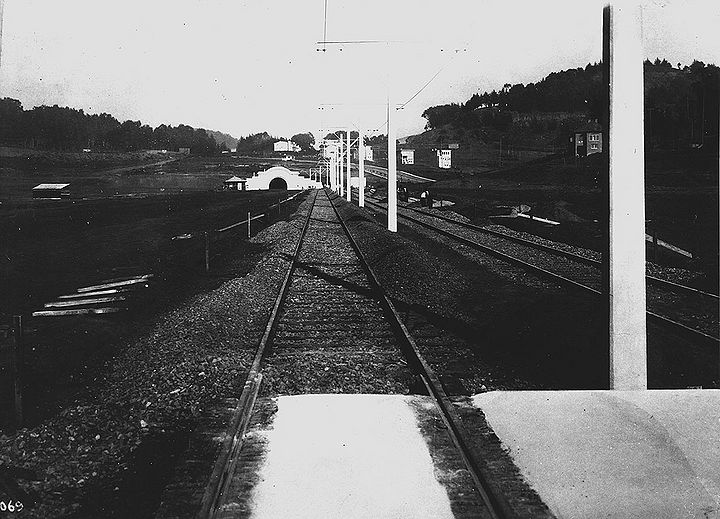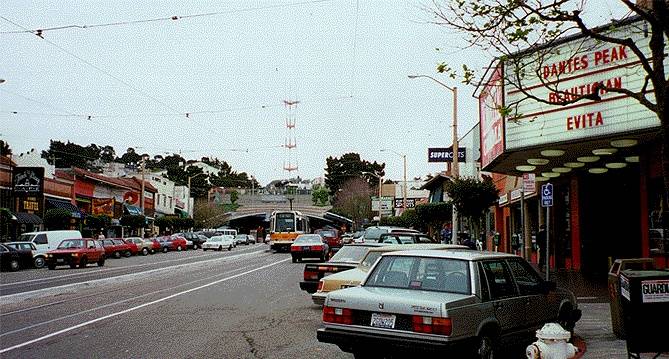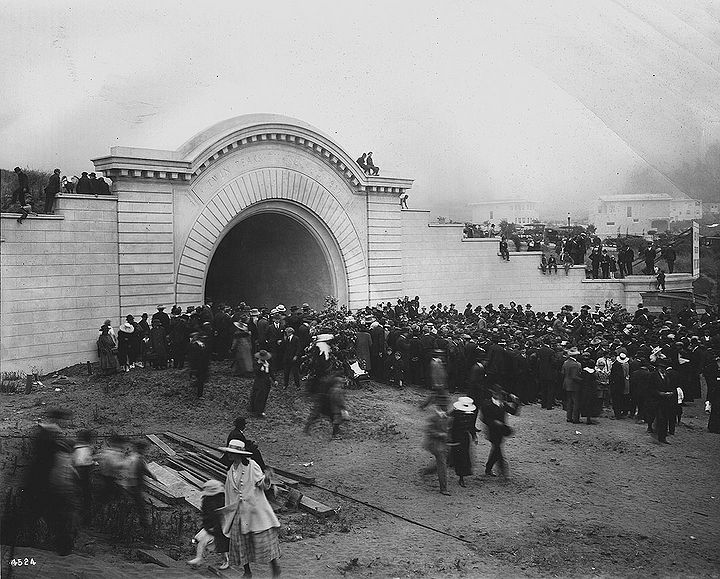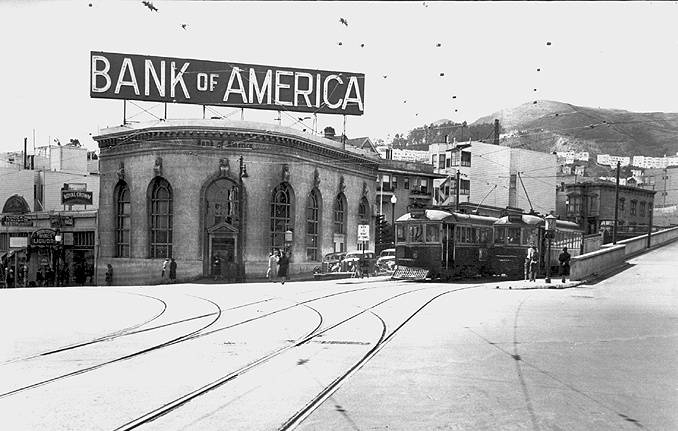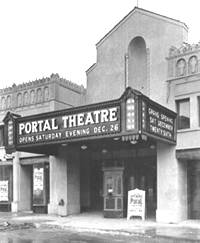West Portal: Difference between revisions
(PC and protected) |
(Changed credits from Greg Garr to Private Collection) |
||
| (13 intermediate revisions by 3 users not shown) | |||
| Line 2: | Line 2: | ||
''by Richard Brandi'' | ''by Richard Brandi'' | ||
''originally published in ''The Argonaut'' Vol. 14, No. 2, Summer 2003.'' | |||
[[Image:West-Portal-and-tracks-pre-urbanization-c-1917.jpg|720px]] | |||
'''West Portal and MUNI tracks before urbanization, 1917.''' | |||
''Photo: Charles Ruiz collection'' | |||
[[Image:sunset$west-portal-photo.jpg]] | |||
View of the West Portal late 1990s, looking towards the Sutro Tower. | |||
''Photo: Chris Carlsson'' | |||
<iframe src="https://archive.org/embed/ssfWSTPORTL" width="640" height="480" frameborder="0" webkitallowfullscreen="true" mozallowfullscreen="true" allowfullscreen></iframe> | |||
'''The West Portal before it was surrounded by housing, c. 1917.''' | |||
''Video: Prelinger Archive'' | |||
The West Portal shopping and residential district takes its name from the [[Twin Peaks Tunnel|Twin Peaks Tunnel]], which ushered in streetcar service to the southeast corner of San Francisco in 1918. MUNI streetcar service opened San Francisco's last great wilderness to residential development. Formerly sand dunes and vegetable farms, today West Portal is the area bounded by Portola, Kensington, Taraval, and 15th Avenue. High quality homes on detached lots lead to rapid growth in the 1920s and set the stage for West Portal to become the commercial and transportation hub for the West of Twin Peaks area. | The West Portal shopping and residential district takes its name from the [[Twin Peaks Tunnel|Twin Peaks Tunnel]], which ushered in streetcar service to the southeast corner of San Francisco in 1918. MUNI streetcar service opened San Francisco's last great wilderness to residential development. Formerly sand dunes and vegetable farms, today West Portal is the area bounded by Portola, Kensington, Taraval, and 15th Avenue. High quality homes on detached lots lead to rapid growth in the 1920s and set the stage for West Portal to become the commercial and transportation hub for the West of Twin Peaks area. | ||
[[Image:West-Portal-Opening-1917.jpg|720px]] | |||
'''West Portal opening, 1917.''' | |||
''Photo: Charles Ruiz collection'' | |||
In Spanish times, West Portal was part of the land holdings of Mission de Dolores. After the break up of the Missions, Jose de Jesus Noe was granted a 4,443 acre ranch in 1846, called [[Rancho San Miguel Disappears|Rancho San Miguel]]. The ranch ran from present day UCSF in Parnassus Heights to San Jose Avenue, south to Daly City and north to Juniper Serra Boulevard and Forest Hill, including the area of present day West Portal. Parts of the ranch east of Twin Peals were subdivided in the late 1800s and became Noe Valley, Eureka Valley, [[Fairmount Heights|Fairmont Heights]], [[Category:Glen_Park|Glen Park]] and Sunnyside. | In Spanish times, West Portal was part of the land holdings of Mission de Dolores. After the break up of the Missions, Jose de Jesus Noe was granted a 4,443 acre ranch in 1846, called [[Rancho San Miguel Disappears|Rancho San Miguel]]. The ranch ran from present day UCSF in Parnassus Heights to San Jose Avenue, south to Daly City and north to Juniper Serra Boulevard and Forest Hill, including the area of present day West Portal. Parts of the ranch east of Twin Peals were subdivided in the late 1800s and became Noe Valley, Eureka Valley, [[Fairmount Heights|Fairmont Heights]], [[Category:Glen_Park|Glen Park]] and Sunnyside. | ||
| Line 19: | Line 45: | ||
'''West side of Castro St. at Market showing the entrance to Twin Peaks Tunnel. Dec. 1922''' | '''West side of Castro St. at Market showing the entrance to Twin Peaks Tunnel. Dec. 1922''' | ||
''Photo: | ''Photo: Private Collection, San Francisco'' | ||
The area was originally called "West Portal Park" in a vain attempt to capitalize on the "residential park" mystique. The name didn't stick partly because of its proximity to the tunnel entrance. Three streetcars lines (Parkside "L" line, Ingleside "K" Line, and Oceanview "M" Line) ran through the area along a new street, West Portal Avenue, which paralleled Portola Way. Stores and other commercial activities were attracted to this new transit thoroughfare. | The area was originally called "West Portal Park" in a vain attempt to capitalize on the "residential park" mystique. The name didn't stick partly because of its proximity to the tunnel entrance. Three streetcars lines (Parkside "L" line, Ingleside "K" Line, and Oceanview "M" Line) ran through the area along a new street, West Portal Avenue, which paralleled Portola Way. Stores and other commercial activities were attracted to this new transit thoroughfare. | ||
| Line 30: | Line 56: | ||
[[Image:EmpireTheatre3in.jpg]] | [[Image:EmpireTheatre3in.jpg]] | ||
'''Empire Theatre, originally the Portal Theatre''' | |||
''Photo: courtesy of Richard Brandi'' | ''Photo: courtesy of Richard Brandi'' | ||
| Line 41: | Line 69: | ||
But the need for better transportation led to the creation of BART in 1962, which posed a new challenge to West Portal. BART planners wanted to dig up West Portal Avenue so that MUNI streetcars could go underground all the way to Sloat Boulevard. West Portal merchants and neighbors, mindful of the chaos on Market Street during BART construction, defeated that idea. | But the need for better transportation led to the creation of BART in 1962, which posed a new challenge to West Portal. BART planners wanted to dig up West Portal Avenue so that MUNI streetcars could go underground all the way to Sloat Boulevard. West Portal merchants and neighbors, mindful of the chaos on Market Street during BART construction, defeated that idea. | ||
But they were not successful in keeping the original West Portal tunnel entrance, an imposing Beaux Art landmark that was demolished in 1976 to build the current West Portal MUNI Metro station. The Ford administration found the facade eligible as a National Historic Place but local West Portal merchants thought it was an eyesore. The | But they were not successful in keeping the original West Portal tunnel entrance, an imposing Beaux Art landmark that was demolished in 1976 to build the current West Portal MUNI Metro station. The Ford administration found the facade eligible as a National Historic Place but local West Portal merchants thought it was an eyesore. The new station wound up costing $8.5 million, more than twice the entire amount of the 2 1/4 mile tunnel in 1918. | ||
Until recently, most residents were the adult offspring of the people who first settled West Portal, giving the area one of the highest percentage of people over age 60 in the City. The author remembers West Portal in the late 1980s with only a few restaurants and no coffee houses, perhaps the last "authentic" neighborhood in San Francisco. Today, while West Portal remains a land of single-family homes, the first generation has given way to an influx of new families with above average incomes and higher education. | Until recently, most residents were the adult offspring of the people who first settled West Portal, giving the area one of the highest percentage of people over age 60 in the City. The author remembers West Portal in the late 1980s with only a few restaurants and no coffee houses, perhaps the last "authentic" neighborhood in San Francisco. Today, while West Portal remains a land of single-family homes, the first generation has given way to an influx of new families with above average incomes and higher education. | ||
| Line 47: | Line 75: | ||
They come seeking the same amenities: good shopping, low density, convenient MUNI service to downtown and the new housing stock (that is, relatively "new" for San Francisco). More than two dozen eating places offer a variety of cuisines and there are even a few national chains, including the ubiquitous Starbucks. While Fernando Nelson didn't quite succeed in building a residential park, he did create a charming village that endures. | They come seeking the same amenities: good shopping, low density, convenient MUNI service to downtown and the new housing stock (that is, relatively "new" for San Francisco). More than two dozen eating places offer a variety of cuisines and there are even a few national chains, including the ubiquitous Starbucks. While Fernando Nelson didn't quite succeed in building a residential park, he did create a charming village that endures. | ||
<iframe src="https://archive.org/embed/TwinPeaksTunnel1917" width="640" height="480" frameborder="0" webkitallowfullscreen="true" mozallowfullscreen="true" allowfullscreen></iframe> | |||
'''Twenty minutes restored archival film of building the Twin Peaks Tunnel. Full explanatory notes [[Twin Peaks Tunnel|here]].''' | |||
'' | ''Video: [https://archive.org/details/opensource_movies Internet Archive]'' | ||
[[St. Francis Wood |Prev. Document]] [[ | [[St. Francis Wood |Prev. Document]] [[Patty Hearst Bankrobber|Next Document]] | ||
[[category:Sunset]] [[category:1990s]] [[category:1910s]] [[category:Transit]] [[category:Encyclopedia]] [[category:West of Twin Peaks]] [[category:West Portal]] | [[category:Sunset]] [[category:1990s]] [[category:1910s]] [[category:Transit]] [[category:Encyclopedia]] [[category:West of Twin Peaks]] [[category:West Portal]] [[category:Theaters]] [[category:The Argonaut]] | ||
Latest revision as of 15:09, 16 June 2014
Historical Essay
by Richard Brandi
originally published in The Argonaut Vol. 14, No. 2, Summer 2003.
West Portal and MUNI tracks before urbanization, 1917.
Photo: Charles Ruiz collection
View of the West Portal late 1990s, looking towards the Sutro Tower.
Photo: Chris Carlsson
<iframe src="https://archive.org/embed/ssfWSTPORTL" width="640" height="480" frameborder="0" webkitallowfullscreen="true" mozallowfullscreen="true" allowfullscreen></iframe>
The West Portal before it was surrounded by housing, c. 1917.
Video: Prelinger Archive
The West Portal shopping and residential district takes its name from the Twin Peaks Tunnel, which ushered in streetcar service to the southeast corner of San Francisco in 1918. MUNI streetcar service opened San Francisco's last great wilderness to residential development. Formerly sand dunes and vegetable farms, today West Portal is the area bounded by Portola, Kensington, Taraval, and 15th Avenue. High quality homes on detached lots lead to rapid growth in the 1920s and set the stage for West Portal to become the commercial and transportation hub for the West of Twin Peaks area.
West Portal opening, 1917.
Photo: Charles Ruiz collection
In Spanish times, West Portal was part of the land holdings of Mission de Dolores. After the break up of the Missions, Jose de Jesus Noe was granted a 4,443 acre ranch in 1846, called Rancho San Miguel. The ranch ran from present day UCSF in Parnassus Heights to San Jose Avenue, south to Daly City and north to Juniper Serra Boulevard and Forest Hill, including the area of present day West Portal. Parts of the ranch east of Twin Peals were subdivided in the late 1800s and became Noe Valley, Eureka Valley, Fairmont Heights, and Sunnyside.
But West Portal remained a ranch until well after the 20th Century. Adolph Sutro bought the remnant of the original rancho in 1880 -- a 1,200-acre parcel that ran from present day UCSF, south along Stanyan Street, up over Twin Peaks due south roughly along present-day Ridgewood Avenue, continuing south to the Ocean View district, then north along Junipero Serra Boulevard to the Laguna Honda reservoir.
While most of the ranch was hilly, the area that later became West Portal was relatively flat, and Sutro rented it to Italian vegetable farmers. For the next 35 years, the rest of Rancho San Miguel remained a nature preserve. Sutro's passion for tree planting eventually covered the slopes of Mt. Sutro and Mt. Davidson as far south as Ocean Avenue with eucalyptus.
When the rancho was put up for sale in 1909 after a contentious battle over Sutro's will, the City was desperate to recover from the 1906 earthquake and fire. City boosters badly wanted to compete with new subdivisions being built on the Peninsula and in the East Bay. The Burnham plan of 1905 and the City Beautiful Movement called for respecting the contours of the land and incorporating landscaping into residential developments. It was no longer acceptable to pack houses tightly together on rectangular street grids that ignored the terrain.
The first neighborhoods to be developed, St Francis Wood and Forest Hill in 1912, were faithful to these new ideas and were carefully designed and built as "residential parks." Both developments prohibited commercial activities and were made up exclusively of large homes from the Craftsman movement, the Chicago school, the prairie style of Frank Lloyd right, the Beaux-Arts, and other styles. In contrast, West Portal became a commercial and transportation hub with homes in a wide variety of architectural styles.
West side of Castro St. at Market showing the entrance to Twin Peaks Tunnel. Dec. 1922
Photo: Private Collection, San Francisco
The area was originally called "West Portal Park" in a vain attempt to capitalize on the "residential park" mystique. The name didn't stick partly because of its proximity to the tunnel entrance. Three streetcars lines (Parkside "L" line, Ingleside "K" Line, and Oceanview "M" Line) ran through the area along a new street, West Portal Avenue, which paralleled Portola Way. Stores and other commercial activities were attracted to this new transit thoroughfare.
Additionally, Fernando Nelson, who bought the land and developed much of West Portal, was not an architect but a self-made developer. A builder in San Francisco since 1876, he and his sons built homes adjacent to newly constructed streetcar lines in the Richmond and Sunset districts.
West Portal reflects Fernando Nelson and Sons interpretations of contemporary designs. Their first homes, along Portola Drive, mimic the large Arts and Crafts or Spanish style homes across the street in St. Francis Wood. For example, 1590 Portola Drive was completed in 1917 at a cost of $14,000, comparable in cost and size to those selling in St Francis. (It recently listed for $1.3 million). But his later houses follow no pattern. The 1920s was a period of tremendous variety in architectural styles, with revivals of Colonial, Tudor, Spanish, and Italianate styles. Nelson followed the trends including some "Marina" style homes as well.
The notable architectural exception in West Portal is the Empire Theatre designed by Garren and Morrow in 1925. This was an imposing Mediterranean style movie house until much of the original detailing was stripped in later years. (Irving Morrow was the consulting architect for the Golden Gate Bridge and he and his wife are credited for the bridge's Moderne detailing). Another exception is designed the apartment house at 330 West Portal Avenue designed by Hermann Baumann in 1931. Baumannn was a prolific architect who built more than 400 apartment buildings in the 1920s and 1930s throughout the Bay Area. He is especially known for the fine detailing in the building's lobbies.
Empire Theatre, originally the Portal Theatre
Photo: courtesy of Richard Brandi
Although no architecturally significant structures have been designated on West Portal Avenue, the movie theater has been a fixture since it opened as the "Portal Theatre" on December 26, 1925. Renamed and re-opened on October 1, 1936 as the "Empire", it had its single screen split into three in 1974.
By the 1930s West Portal looked largely as it does today, a line of shops and a few apartment buildings along West Portal Avenue surrounded by single family homes on the side streets. The Great Depression and World War II did little to change the character of the neighborhood. But the post-war population boom lead traffic engineers to plan a series of freeways that would criss-cross San Francisco, including West Portal.
The "Western Freeway" was run north from present day I-280 along Junipero Serra Boulevard north of Sloat where it would turn northeast and tunnel under Forest Hill and join the Crosstown Freeway running from Glen Park Canyon. Many homes stood in the way. Neighborhood clubs, including the West Portal Home Owners Association, challenged the Division of Highways at a meeting on December 2, 1955 in Lincoln High School. This intensified public concern and, along with opposition to other freeways, lead to the famous freeway revolt by the Board of Supervisors in 1959. Although studies continued for a more few years, the freeway was dead.
But the need for better transportation led to the creation of BART in 1962, which posed a new challenge to West Portal. BART planners wanted to dig up West Portal Avenue so that MUNI streetcars could go underground all the way to Sloat Boulevard. West Portal merchants and neighbors, mindful of the chaos on Market Street during BART construction, defeated that idea.
But they were not successful in keeping the original West Portal tunnel entrance, an imposing Beaux Art landmark that was demolished in 1976 to build the current West Portal MUNI Metro station. The Ford administration found the facade eligible as a National Historic Place but local West Portal merchants thought it was an eyesore. The new station wound up costing $8.5 million, more than twice the entire amount of the 2 1/4 mile tunnel in 1918.
Until recently, most residents were the adult offspring of the people who first settled West Portal, giving the area one of the highest percentage of people over age 60 in the City. The author remembers West Portal in the late 1980s with only a few restaurants and no coffee houses, perhaps the last "authentic" neighborhood in San Francisco. Today, while West Portal remains a land of single-family homes, the first generation has given way to an influx of new families with above average incomes and higher education.
They come seeking the same amenities: good shopping, low density, convenient MUNI service to downtown and the new housing stock (that is, relatively "new" for San Francisco). More than two dozen eating places offer a variety of cuisines and there are even a few national chains, including the ubiquitous Starbucks. While Fernando Nelson didn't quite succeed in building a residential park, he did create a charming village that endures.
<iframe src="https://archive.org/embed/TwinPeaksTunnel1917" width="640" height="480" frameborder="0" webkitallowfullscreen="true" mozallowfullscreen="true" allowfullscreen></iframe>
Twenty minutes restored archival film of building the Twin Peaks Tunnel. Full explanatory notes here.
Video: Internet Archive

